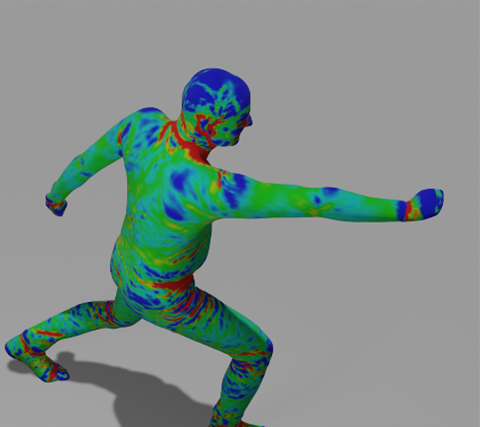Curvature change of moving bodies and its application for development of protective elements for protective clothing
DOI:
https://doi.org/10.25367/cdatp.2023.4.p132-140Keywords:
curvature, protection clothing, safety, comfort, body movements, body scanAbstract
When the human body moves, the body curvatures always change on the corresponding parts of the body. For ideal protective clothing, body curvatures during different movements have to be taken into account, as they influence the protection and the wearing comfort. For this reason, this study will focus on demonstrating methods to visually display such curvature changes. The changes are visually shown in different poses. The aim is to use this method to optimize protective elements on body parts with increased curvature changes. This would make protective clothing safer and more comfortable to wear.
References
Habitz, A. Gewalt im Rettungsdienst: Eigensicherung Deeskalation Selbstverteidigung; Springer: Berlin, Heidelberg, 2019.
Ahrendt, D.; Krzywinski, S.; Justo i Massot, E.; Krzywinski, J. Hybrid material designs by the example of additive manufacturing for novel customized stab protective clothing. Light Weight Armour Group for Defense and Security, 2019, 284–294.
Restle, S. Ballistische Schutzwesten und Stichschutzoptionen; Nebel-Verlag, Eggolsheim, 2004.
Shin, H.-S.; Erlich, D.C.; Shockey, D.A. Test for measuring cut resistance of yarns. Journal of Materials Science 2003, 38, 3603–3610.
M. J. Decker; C. Halbach; C. Nam; N. Wagner; E. Wetzel. Stab resistance of shear thickening fluid (STF)-treated fabrics. Composites Science and Technology 2007, 67, 565-578.
Elmessiry, M. Investigation of puncture behaviour of flexible silk fabric composites for soft body armour. Fibres and Textiles in Eastern Europe 2014, 22, 71–76.
Flambard, X.; Polo, J. Stab resistance of multi-layers knitted structures: Comparison between para-aramid and PBO fibers. Journal of Advanced Materials 2004, 36, 30-35.
Malik, T.; Barhanpurkar, S.; Ballistic Protection Fabric, Technical Textiles 2018, pp. 1-11.
Wohlers, T.; Campbell, R.I.; Diegel, O.; Kowen, J.; Mostow, N.; Fidan, I. Wohlers report 2022 3D printing and additive manufacturing. Global state of the industry; Wohlers Associates, ASTM International, Fort Collins, Colorado, Washington, DC, 2022.
Guo, Y.; Yuan, M.; Qian, X. Bionic stab-resistant body armor based on triangular pyramid structure. Defence Technology 2021, 17, 792–799.
Gong, Z.; Qian, X.; Yuan, M. Structural design of a 3-D printed stab resistant body armor. Rapid Prototyping Journal 2019, 25, 143–151.
Muenks, D.; Sprenger, A.M.; Kyosev, Y. Design of additively manufactured composite elements with long and short fiber reinforcements for improved stab protection. In: Proceedings of the 20th European Conference on Composite Materials – Composites Meet Sustainability; EPFL Lausanne, Composite Construction Laboratory, 2022; vol. 2, pp. 1108–1114.
Muenks, D.; Pilgrim, J.; Kyosev, Y. Possibilities for qualitative evaluation of the protection area of protective clothing. CDATP 2022, 3, 156–162.
Muenks, D.; Eckelmann, L.; Kyosev, Y. Non-planar 3D printed elements on textile substrate using a fused filament fabrication 3D printer. Autex Research Journal 2022, online first. DOI: https://doi.org/10.2478/aut-2022-0026.
Münks, D.; Eckelmann, L.; Kyosev, Y. In: Tagungsband zur 17. Chemnitzer Textiltechnik-Tagung: Textiltechnik als Schlüsseltechnologie der Zukunft, Chemnitz, 28. - 29. September 2022; Förderverein Cetex, Technische Universität Chemnitz, Eds.; Förderverein Cetex Chemnitzer Textilmaschinenentwicklung e.V.: Chemnitz, 2022; pp. 208–214.
Blender Foundation. About — blender.org. https://www.blender.org/about/ (accessed January 9, 2023).
Mixamo. https://www.mixamo.com/#/ (accessed January 9, 2023).
Cignoni, P.; Callieri, M.; Corsini, M.; Dellepiane, M.; Ganovelli, F.; Ranzuglia, G.; et al.. In: Eurographics Italian chapter conference 2008, 2008, 129–136.
InspirationTuts (iTuts Editor). What is UV Mapping & Unwrapping? (full beginners guide). https://inspirationtuts.com/what-is-uv-mapping-and-unwrapping/ (accessed January 19, 2023).
Petty, J. What is 3D Rigging For Animation & Character Design? https://conceptartempire.com/what-is-rigging/ (accessed January 19, 2023).
Roberts, A. Curvature attributes and their application to 3D interpreted horizons. First Break 2001, 19, 85–100.
Tsagkrasoulis, D.; Hysi, P.; Spector, T.; Montana, G. Heritability maps of human face morphology through large-scale automated three-dimensional phenotyping. Sci Rep. 2017, 7, 45885.

Downloads
Published
How to Cite
Issue
Section
License
Copyright (c) 2023 Dominik Muenks, Yordan Kyosev, Xia Shuang

This work is licensed under a Creative Commons Attribution-NonCommercial-NoDerivatives 4.0 International License.





